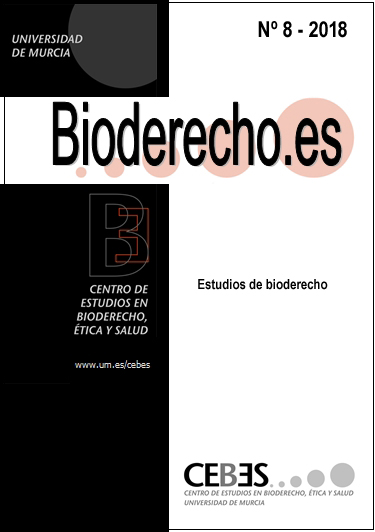Bioethical perspective of Attention Deficit Hiperactivity Disorder (ADHD)
Abstract
The emergence of the welfare state in the mid-twentieth century had health consequences that culminated in the recognition of the right to health protection and the duty of health care of the State, with an extension of medicine to unknown fields, medicalizing the life of people. ADHD is a paradigmatic case, becoming a psychiatric pathology due to its inclusion in the DSM-III 1980, with inconsistencies and subjectivity in the classifications. The etiology of the disorder is unknown, its diagnosis is subjective and doubtful, its treatment ineffective and with risks, increasing the number of cases diagnosed and the benefits of the pharmaceutical industry. From the Bioethics a reflection on the possible damages derived from the medicalization (nonmaleficence), a prudent action of the professional (beneficence), respect to the criterion of children and adolescents (autonomy) and a critical perspective in relation to the expense is imposed derived from his diagnosis (justice).
Downloads
-
Abstract1475
-
PDF (Español (España))912
References
EDITORIAL (2005),“Medicalización de la vida y creación de enfermedades”, enInformación Farmacoterapéutica de la comarca (Infac), volumen 13, número 7, 29-32.
FEITO,L.(1996). “La definición de la salud”, enDiálogo filosófico, 34, 61-84.
FRANCES,A.(2014). ¿Somos todos enfermos mentales?Barcelona: Ariel.
GØTSZCHE,P.(2016). Psicofármacos que matan y denegación organizada. Barcelona: Los librosdel lince.
GUÍA DE PRÁCTICA CLÍNICAsobre el Trastorno por Déficit de Atención con Hiperactividad (TDAH) en Niños y Adolescentes (2010).Ministerio de Sanidad, Política social e Igualdad.
LÓPEZ,C.J.(2015). “La medicalización de la infancia en salud mental: el caso paradigmático de los trastornos de atención”, enPapeles del Psicólogo, 36 (3) 174-181.
RUIZ,P.J.(2014). “TDAH: aspectos éticos y legales”, enPediatría Integral. XVIII (9), 678-688.
SÁIZ,L.C.(2013). “Atentos al déficit de atención. Entrela naturaleza incierta y la prescripción hiperactiva”, enBoletín de información farmacoterapéutica de Navarra, (21), 1-19.
MOYNIHAN,R,SMITH,R.(2002). “Too much medicine?”, enBrithis Medical Journal 324(7342):859-60.
VALVERDE,M.A.(2015). “El arte de hacer visible lo invisible: el marketing en el TDAH”, enNorte de salud mental, (52), 11-26.
VALVERDE,M.A.YINCHAUSPE,J.A.(2014). “Alcance y límites del tratamiento farmacológico del Trastorno por Déficit de Atención e Hiperactividad en niños y adolescentes y Guías de Práctica Clínica. Una revisión bibliográfica”, enRevista Asociación Española de Neuropsiquiatría, 34 (121), 37-74.
WHITAKER,R.(2015). Anatomía de una epidemia. Madrid: Capitán Swing.
YOUNG,S.,FITZGERALD,M.Y POSTMA,M.(2013), Hacer visible lo invisible. Libro Blanco sobre el trastorno por déficit de atención con hiperactividad (TDAH): propuestas políticas para abordar el impacto social, el coste y los resultados a largo plazo en apoyo a los afectados.Enhttps://www.aepap.org/sites/default/files/documento/archivos adjuntos/libroblancotdah.pdf(consultado el 20 de octubre de 2018)
Los autores que publican en esta revista están de acuerdo con los siguientes términos:
- Los autores conservan los derechos de autor y garantizan a la revista el derecho de ser la primera publicación del trabajo, con la obra disponible simultáneamente bajo una licencia Creative Commons Atribución-Compartir Igual 4.0 Internacional (CC BY-SA 4.0), que permite a otros copiar y redistribuir la obra en cualquier medio o formato, remezclar, transformar y construir a partir de la obra para cualquier propósito, incluso comercialmente, siempre que: a) se reconozca la autoría y publicación inicial en esta revista; b) se indiquen los cambios realizados; y c) si se transforma o crea a partir de la obra, se distribuya la contribución bajo la misma licencia CC BY-SA 4.0.
- Los autores pueden establecer por separado acuerdos adicionales para la distribución no exclusiva de la versión de la obra publicada en la revista (por ejemplo, situarlo en un repositorio institucional o publicarlo en un libro), con un reconocimiento de su publicación inicial en esta revista.
- Se permite y se anima a los autores a difundir sus trabajos electrónicamente (por ejemplo, en repositorios institucionales o en su propio sitio web) antes y durante el proceso de envío, ya que puede dar lugar a intercambios productivos, así como a una citación más temprana y mayor de los trabajos publicados (Véase The Effect of Open Access) (en inglés).



